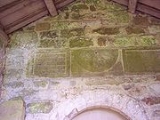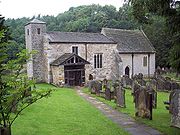
Kirkdale sundial
Encyclopedia


Anglo-Saxons
Anglo-Saxon is a term used by historians to designate the Germanic tribes who invaded and settled the south and east of Great Britain beginning in the early 5th century AD, and the period from their creation of the English nation to the Norman conquest. The Anglo-Saxon Era denotes the period of...
sundial
Sundial
A sundial is a device that measures time by the position of the Sun. In common designs such as the horizontal sundial, the sun casts a shadow from its style onto a surface marked with lines indicating the hours of the day. The style is the time-telling edge of the gnomon, often a thin rod or a...
at St Gregory's Minster
St Gregory's Minster
St Gregory's Minster is an Anglo-Saxon church with a rare sundial, in Kirkdale near Kirkbymoorside, Vale of Pickering, North Yorkshire, England. It is a Grade I listed building.The minster was built c...
, Kirkdale
Kirkdale, North Yorkshire
Kirkdale is a valley in North Yorkshire, England, which along with Sleightholmedale makes up the larger Bransdale and carries the Hodge Beck from its moorland source near Cockayne to the River Dove and onto the River Rye in the Vale of Pickering....
, near Kirkbymoorside
Kirkbymoorside
Kirkbymoorside is a small market town and civil parish in the Ryedale district of North Yorkshire, England which lies approximately 25 miles north of York midway between Pickering and Helmsley, and has a population of approximately 3,000.-History:...
, North Yorkshire
North Yorkshire
North Yorkshire is a non-metropolitan or shire county located in the Yorkshire and the Humber region of England, and a ceremonial county primarily in that region but partly in North East England. Created in 1974 by the Local Government Act 1972 it covers an area of , making it the largest...
, England
England
England is a country that is part of the United Kingdom. It shares land borders with Scotland to the north and Wales to the west; the Irish Sea is to the north west, the Celtic Sea to the south west, with the North Sea to the east and the English Channel to the south separating it from continental...
dates to the mid 11th century. The panel containing the actual sundial above the church doors is flanked by two panels, bearing an inscription in Old English
Old English language
Old English or Anglo-Saxon is an early form of the English language that was spoken and written by the Anglo-Saxons and their descendants in parts of what are now England and southeastern Scotland between at least the mid-5th century and the mid-12th century...
:
- + ORM GAMAL / SVNA BOHTE SCS / GREGORIVS MIN / STER ÐONNE HI / T ǷFS ÆL TOBRO // CAN ⁊ TOFALAN ⁊ HE / HIT LET MACAN NEǷAN FROM / GRVNDE ΧΡE ⁊ SCS GREGORI / VS IN EADǷARD DAGVM CNG / IN TOSTI DAGVM EORL +
- Orm Gamal suna bohte Sanctus Gregorius minster ðonne hit wæs æl tobrocan and tofalan, and he hit let macan newan from grunde Christe et Sancti Gregori, in Eadward dagum cuning, in Tosti dagum eorl. (ǷFS being a mistake for ǷES or ǷÆS)
- "Orm son of Gamal son bought St. Gregory's minster when it was all broken and fallen down and he let it be made new from the ground, for Christ and St. Gregory, in the days of Edward king, in the days of Tosti the eorl"

- + ÞIS IS DÆGES SOLMERCA + / ÆT ILCVM TIDE
- þis is dæges solmerca, æt ilcum tide.
- "This is the day's sun-marker, at every tide."
And at the bottom of the central panel is the line
- +⁊ HAǷARÐ ME ǷROHTE ⁊ BRAND / PRS
- and Haward me wrohte, and Brand, presbyter(i).
- "And Haward wrought me, and Brand, priest(s)."
The reference is to Edward the Confessor
Edward the Confessor
Edward the Confessor also known as St. Edward the Confessor , son of Æthelred the Unready and Emma of Normandy, was one of the last Anglo-Saxon kings of England and is usually regarded as the last king of the House of Wessex, ruling from 1042 to 1066....
and Earl Tostig
Tostig Godwinson
Tostig Godwinson was an Anglo-Saxon Earl of Northumbria and brother of King Harold Godwinson, the last crowned english King of England.-Early life:...
, Edward's brother-in-law, who was the son of Earl Godwin of Wessex and the brother of Harold
Harold Godwinson
Harold Godwinson was the last Anglo-Saxon King of England.It could be argued that Edgar the Atheling, who was proclaimed as king by the witan but never crowned, was really the last Anglo-Saxon king...
. Tostig held the Earldom of Northumbria
Northumbria
Northumbria was a medieval kingdom of the Angles, in what is now Northern England and South-East Scotland, becoming subsequently an earldom in a united Anglo-Saxon kingdom of England. The name reflects the approximate southern limit to the kingdom's territory, the Humber Estuary.Northumbria was...
from 1055 to 1065 fixing the date of the church's reconstruction to that decade. He is also known for the murder of Gamal, Orm's father. The language of the inscription is late Old English, with a failing case and gender system. The compound solmerca is otherwise unattested in English, and has been ascribed to Scandinavian
Norsemen
Norsemen is used to refer to the group of people as a whole who spoke what is now called the Old Norse language belonging to the North Germanic branch of Indo-European languages, especially Norwegian, Icelandic, Faroese, Swedish and Danish in their earlier forms.The meaning of Norseman was "people...
influence (Old Norse
Old Norse
Old Norse is a North Germanic language that was spoken by inhabitants of Scandinavia and inhabitants of their overseas settlements during the Viking Age, until about 1300....
solmerki "sign of the zodiac
Zodiac
In astronomy, the zodiac is a circle of twelve 30° divisions of celestial longitude which are centred upon the ecliptic: the apparent path of the Sun across the celestial sphere over the course of the year...
").

